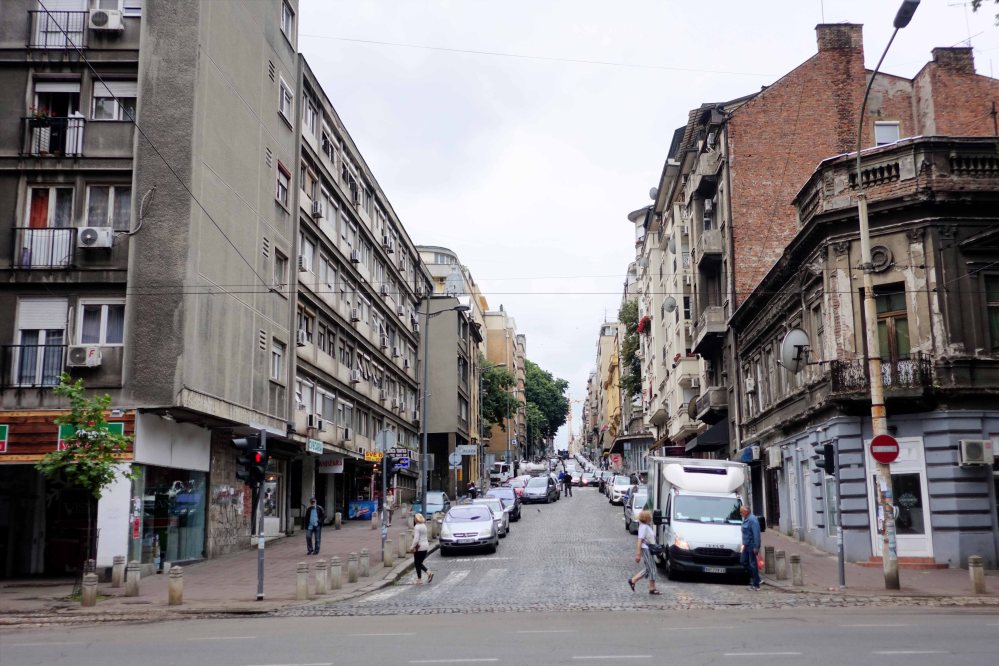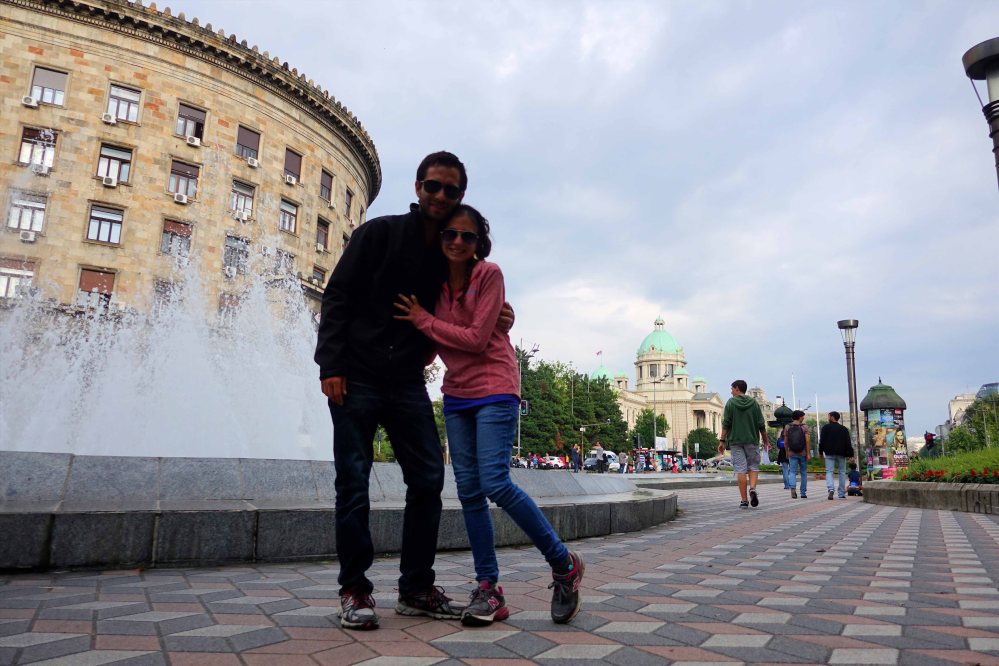We arrived at Serbia! when we exited Belgrade (Serbia capital) airport, the city received us with a thunderstorm. We took a public bus that droped us off at the bus station and from there we couldnt walk as originally intended so we took a taxi.
Serbia is landlocked and borders Hungary to the north; Romania and Bulgaria to the east;Macedonia to the south; and Croatia, Bosnia-Herzegovina, and Montenegro to the west; it also claims a border with Albania through the disputed territory of Kosovo.
The hotel was really cute in the middle of the city, we waited till the rain stopped and walked to the main restaurant area for a nice dinner in a traditional Serbian restaurant.

The next morning we walked towards the Belgrade Castle where most of the city attractions are located. The city looks a little run down and not many people speak English, but they were nice overall.

I have never ever seen a gas station like this. I guess they rather have you pull over in the middle of the street than cutting trees to place that gas station. Props to you Serbia!

We stopped at a local bakery for a quick breakfast. One of the first impressions of this city, besides the number of supermodels walking the streets, is that there are not many breakfast places, people just drink coffee and smoke… which might help on shaping the supermodels.

We continued our walk until we reached the main fortress area. For some unknown reason, someone decided that a dinosaur park here would be a great idea.

The Belgrade Fortress consists of the old citadel and Kalemegdan Park on the confluence of the River Sava and Danube. The fortress was built by the Celts. Then, it was conquered by the Romans and was known as Singidunum and became a part of “the military frontier”, where the Roman Empire bordered “barbarian Central Europe”. The fortress was conquered by many civilizations including the Huns, Bizantine Empire, Turks and others. Which is why they have a pretty amazing military museum right there.

The military museum takes you around the many civilizations and armies that lived or passed through this area. The exhibits are extremely well kept with very interesting real weapons. As a strategic location, the city was battled over in 115 wars and razed to the ground 44 times. Belgrade was the capital of Yugoslavia from its creation in 1918, to its final dissolution in 2006.

The most interesting to me (Eitan) is where they have a part of the American F-117 Nighthawk Stealth aircraft that was shot down in 1999 during the NATO bombing of Yugoslavia.

The exterior fortress wall is surrounded by tanks and artillery from different decades.

There are a few nice viewpoints from the fortress walls where you can see the Sava river. This river connects three national capitals—Ljubljana, Zagreb and Belgrade.

Belgrade has 1.5 million residents and it is slightly smaller than South Carolina in area. Also, Serbia is the largest exporter of raspberries in the world. It contributes 30% of all raspberries to the international market. Ok, enough of stupid facts… lets get back to sightseeing.


Belgrade Fortress is known for its kilometers-long tunnels, underground corridors and catacombs, which are still largely unexplored. In the true sense, fortress is today the green oasis in the Belgrade’s urban area.

Some of the main sights here are a couple of churches. The first one we visited was the Ružica Church. The church was used as a gunpowder magazine in the 18th century, and was converted into a military church between 1867 and 1869. Heavily damaged during the First World War, the church was renovated in 1925. You can see the chandeliers are made out of bullets. I wonder what would Jesus think of that.

The next church a few hundred feet away, was the Saint Petka’s Chapel, beautifully decorated by biblical images made out out lies, sorry, made out of tiles.

This contemporary church was built in 1937, above a miraculous spring. In middle ages, this was the site of a church where the holy remains of St. Petka’s were placed until 1521. The Chapel still guards the saint’s hand, and the ill come to wash their face at the spring. St Petka is much venerated among Belgraders.

The next stop (we are still inside the fortress walls), was the Roman Well. According to the official story, the well was built during the Austrian reconstruction of the Belgrade Fortress in order to provide water for the army, between 1717 and 1732. The notoriety of the ‘Roman Well’ comes from the many tales and legends of prisoners being thrown down the hole throughout the Belgrade history. The latest case was surprisingly recent when in 1954 a mentally ill man killed his wife and threw her body down the well.

The next sight was the underground bunker, it was built at the beginning of the 1950s and it is one of several hundred cannon, machine gun and other bunkers built in this area. The bunker was built in secret by Tito under the Belgrade Fortress. It went unknown until just a few years ago.

We decided we had enough history for the day and we were starving. We stopped at an amazing Italian restaurant where we waited for the rain to stop. The food was superb.

Walking the city was nice. People started to come out now that the rain was over.

We walked to the famous Church of Saint Seva.It is one of the largest Orthodox churches in the world and ranks among the largest church buildings in the world. The church is dedicated to Saint Sava, the founder of the Serbian Orthodox Church and an important figure in medieval Serbia.

They say the building of the church structure is being financed exclusively by donations. The church started construction in 1985 and its still in progress. I guess they are really taking their time.

We were exhausted already but we only had a day at Belgrade, so we wanted to see everything! We continued to the Nikola Tesla museum. If you didn’t know (we didn’t), Tesla was Serbian. But wait, if you still think I’m talking about the electrical cars (looking at you Sarah), I’m not; Nikola Tesla was the inventor of modern alternating current (AC) electricity supply system and many other things that make your life easier today. So Elon Musk, named his electric car company “Tesla” for obvious reasons. Anyways, the Serbians like to name everything after this guy: Nikola Tesla Airport, Nikola Tesla Highway, Nikola Tesla University, Nikola Tesla toilet paper, etc… its even in their money!!
The museum was about to close so we missed the tour (you need to take the tour to get in). It looked like its full of those electricity experiments that you see in any science museum.

Another quick stop in another church to pray for world peace. We are noticing that their churches (modern ones) are very minimalistic, not a bad thing.

We headed back to the hotel. We passed through the House of the National Assembly of Serbia, or “The parliament” for the un-complicated.

Between its completion in 1938 and 2006, it was the seat of the Parliament of Yugoslavia and later theParliament of Serbia and Montenegro.

We were running low on fresh clothes and being in Europe made us want to look less like hippy backpackers so we went to the main shopping area and both did a little damage at some very affordable shops. We then quickly changed clothes at the hotel and headed out to a nearby trendy bar. Great beer, great prices, beautiful people, not loud, no lines, no bouncer, no ID check, friendly waiters…. is this paradise??

We were starving so we came back to the main street full of traditional restaurants. They had live music, great funky over-enthusiastic music that made everybody smile.

Their menu, if you are interested is full of meat dishes and carbs. Definitely an L.A. hippster nightmare as the Kale, Quinoa and Tofu dishes were nowhere to be seen.

We got the main traditional dish, Cevapcici. This is basically minced meat in finger shape; or another way to see it… they are sausage looking hamburgers. Well, they are not bad, but if this is their national dish, they need to start re-evaluating their culinary heritage ASAP.

Bonus Pic Of The Day: The Serbian Dinar, beautiful banknotes. The earliest use of the dinar dates back to 1214. Nikola Tesla is in the 100 Dinar bill of course.
